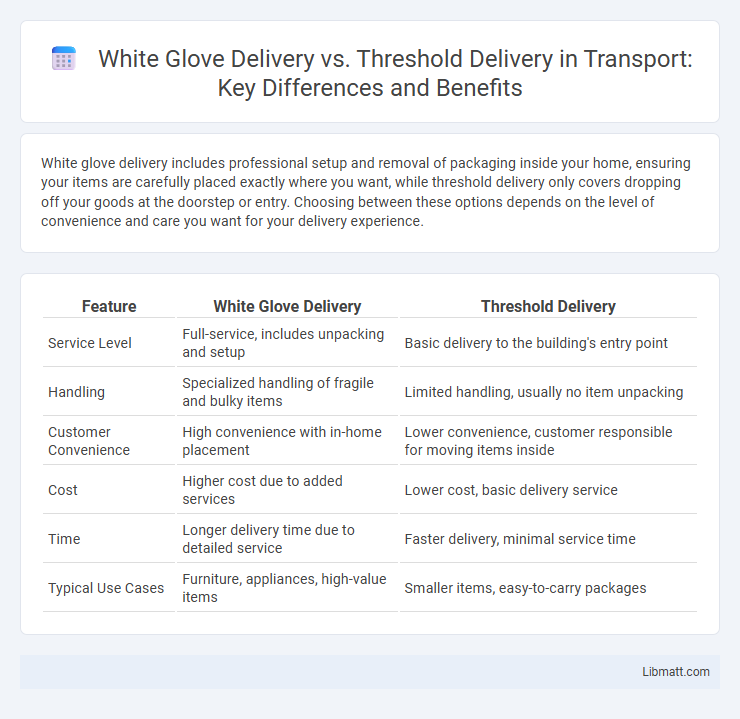White glove delivery includes professional setup and removal of packaging inside your home, ensuring your items are carefully placed exactly where you want, while threshold delivery only covers dropping off your goods at the doorstep or entry. Choosing between these options depends on the level of convenience and care you want for your delivery experience.
Table of Comparison
| Feature | White Glove Delivery | Threshold Delivery |
|---|---|---|
| Service Level | Full-service, includes unpacking and setup | Basic delivery to the building's entry point |
| Handling | Specialized handling of fragile and bulky items | Limited handling, usually no item unpacking |
| Customer Convenience | High convenience with in-home placement | Lower convenience, customer responsible for moving items inside |
| Cost | Higher cost due to added services | Lower cost, basic delivery service |
| Time | Longer delivery time due to detailed service | Faster delivery, minimal service time |
| Typical Use Cases | Furniture, appliances, high-value items | Smaller items, easy-to-carry packages |
Understanding White Glove Delivery
White glove delivery involves professional handlers who not only transport items but also provide in-home setup, assembly, and debris removal, ensuring a seamless customer experience. This service is ideal for heavy, bulky, or delicate goods requiring careful handling and installation, commonly used for appliances and furniture. In contrast, threshold delivery stops at the doorstep, leaving unpacking, assembly, and placement responsibilities to the customer.
What Is Threshold Delivery?
Threshold delivery refers to a shipping service where the carrier delivers the product to the entrance of the customer's home, typically stopping at the front door or garage. This service excludes any inside placement, assembly, or removal of packaging materials, making it a basic delivery option compared to white glove service. Threshold delivery is ideal for customers seeking a cost-effective option without the need for extra handling or setup.
Key Differences Between White Glove and Threshold Delivery
White glove delivery includes inside placement, unpacking, assembly, and debris removal, providing a comprehensive service beyond just doorstep drop-off. Threshold delivery involves placing the item at the entryway without additional setup or cleanup, often requiring the customer to manage further handling. This distinction highlights white glove's premium service tailored for heavy, bulky, or complex items compared to the basic convenience of threshold delivery.
Services Included in White Glove Delivery
White glove delivery includes comprehensive services such as inside delivery, unpacking, assembly, installation, and debris removal, ensuring a hassle-free experience for your new purchase. This premium service caters to bulky or delicate items requiring careful handling and precise placement within your home or office. Choosing white glove delivery guarantees personalized attention and minimizes the effort required on your part.
What to Expect with Threshold Delivery
Threshold delivery involves your items being placed at the main entrance of your home, such as the doorstep or garage, without being moved inside. You should expect minimal interaction with the delivery team and no assistance with unpacking or setup, which means you are responsible for bringing items inside. This service is ideal if you prefer a lower-cost option and don't require extra handling or special care during delivery.
Cost Comparison: White Glove vs Threshold Delivery
White glove delivery typically incurs higher costs compared to threshold delivery due to its comprehensive services, including inside placement, unpacking, and debris removal, which require additional labor and time. Threshold delivery restricts service to dropping off items at the doorstep or entry point, resulting in lower fees and faster delivery times. Businesses must weigh the value of enhanced customer experience and reduced in-home effort against the increased expense of white glove services.
Pros and Cons of White Glove Delivery
White glove delivery offers the advantage of professional handling, unpacking, and setup of your items, reducing the risk of damage and saving you time and effort. However, it often comes at a higher cost compared to threshold delivery, which only involves dropping off the item at your doorstep without additional assistance. Choosing white glove service ensures a seamless experience for bulky or complex items but may not be necessary for simpler deliveries or smaller budgets.
Pros and Cons of Threshold Delivery
Threshold delivery offers a cost-effective option where packages are left at your doorstep, minimizing delivery time and expenses. However, this method carries risks such as potential package theft, weather exposure, and difficulty for recipients with limited mobility. You should weigh these pros and cons to decide if threshold delivery meets your accessibility and security needs.
Choosing the Right Delivery Option for Your Needs
White glove delivery provides comprehensive services including unpacking, assembly, and placement, ideal for fragile or bulky items requiring special care. Threshold delivery simply places your order at the entryway, offering a cost-effective solution for customers comfortable handling setup themselves. Understanding your product's size, fragility, and your willingness to manage installation helps you select the best delivery option for your needs.
Frequently Asked Questions About Delivery Services
White glove delivery includes inside delivery, unpacking, and setup, providing a hassle-free experience for high-value or bulky items, whereas threshold delivery involves dropping the package at your doorstep without additional assistance. Frequently asked questions about delivery services often address the differences in cost, service scope, and whether assembly or placement is included. You should consider your needs for convenience and item complexity when choosing between white glove and threshold delivery options.
white glove delivery vs threshold delivery Infographic

 libmatt.com
libmatt.com